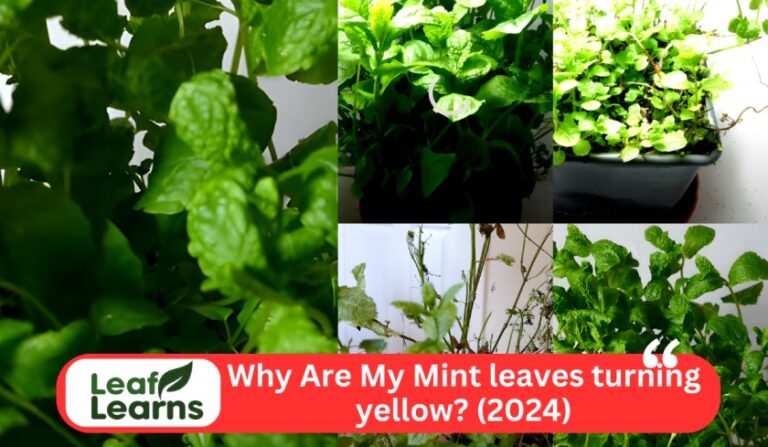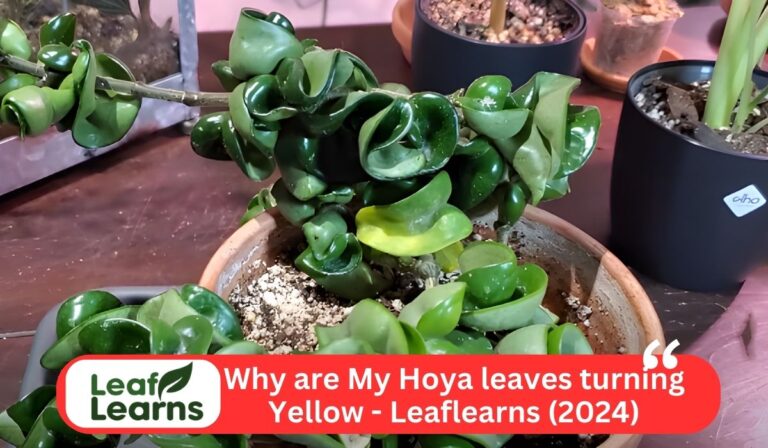Leafy Revelations: Why & When do Monstera Leaves Split (2023)
Exactly when do Monstera leaves splits, and what can you do to encourage them? Discover how proper nutrition, genetics, and wind play a role in Monstera care.
Tropical houseplants such as Monstera are known for their striking foliage. Araceae plant enthusiasts love its large, glossy leaves with unique splits and holes that make it unique.
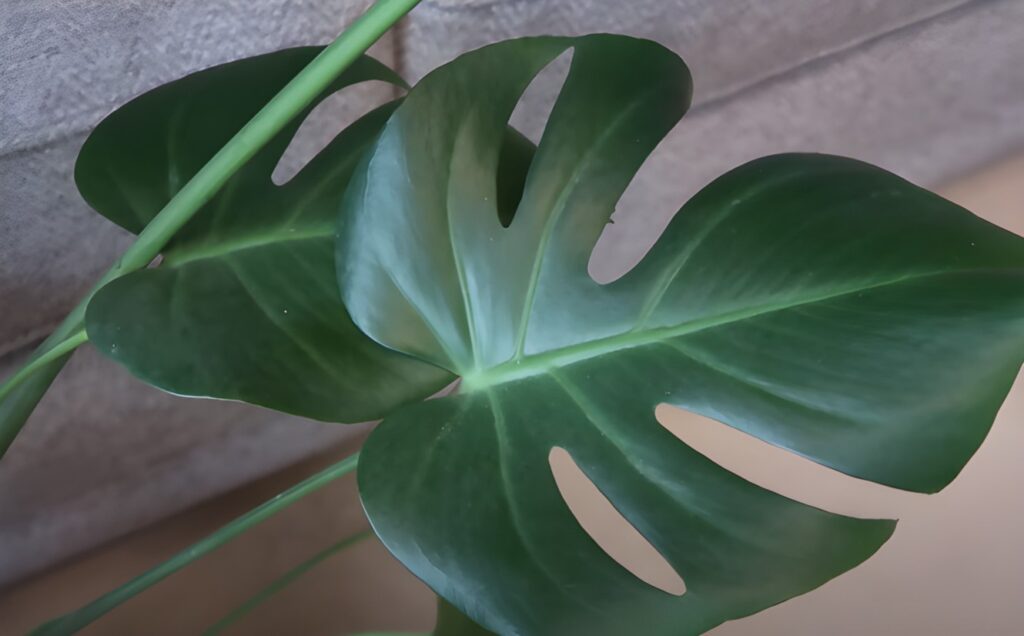
In addition to well-draining soil and bright, indirect light, Monstera plants thrive in well-drained soil. Did you ever wonder why Monstera leaves split? There is a mystery behind water, light, and temperature.
Discover how split leaves evolved and how to troubleshoot them for a thriving Monstera. Learn how to keep your Monstera leaves healthy, vibrant, and beautifully split, no matter how experienced you are as a plant parent.
| Factors | Answer |
| When do Monstera leaves split? | Monstera leaves typically begin to split as the plant matures, often between the ages of 1 to 2 years. However, the specific timing can vary based on factors such as environmental conditions, light exposure, and genetics. Adequate light and proper care contribute to timely leaf splitting. Younger plants may take longer to develop splits, while older, well-cared-for Monstera plants tend to showcase more pronounced splits. |
| Do all Monstera leaves split? | No, not all Monstera leaves necessarily split. The degree of splitting varies among individual leaves and is influenced by factors such as genetics and environmental conditions. Some leaves may have minimal or no splits, while others exhibit more pronounced fenestrations. |
| Why won’t Monstera leaves split? | Several reasons may hinder Monstera leaf splitting: the plant may still be too young, inadequate light exposure, deficits in nutrition or care, or excessive stress. Ensuring optimal conditions, including proper lighting, nutrition, and a supportive environment, can encourage healthy leaf development and splits. |
| How long does it take for Monstera leaves to split? | The timing for Monstera leaves to split varies, but it often begins when the plant is 1 to 2 years old. Factors such as light intensity, temperature, and overall plant health influence the speed of leaf splitting. Patience is crucial, as individual plants may exhibit variations in the timing of this natural process. |
| How to encourage Monstera leaves to split? | Encouraging Monstera leaf splitting involves providing the right conditions: adequate bright, indirect light, balanced fertilizer during the growing season, and maintaining a temperature range between 65-75°F (18-24°C). Proper care, including avoiding excessive stress and providing optimal environmental factors, can promote healthy leaf development and timely splits. |
| Can Monstera stop producing split leaves? | Yes, changes in care, environmental stress, or insufficient light can temporarily halt Monstera leaf splitting. Adjusting care conditions, including providing proper lighting and maintaining a stable environment, can encourage the plant to resume healthy leaf development and splits. |
Contents
- 1 Why Do Monstera Leaves Split?
- 2 When Do Monstera Leaves Split?
- 3 How Do You Encourage Monstera Leaf Splitting?
- 4 What does Monstera Split Mean?
- 5 Reasons Your Monstera Leaves May Not Be Splitting
- 6 Stress Factors
- 7 Why Monstera Leaves Turn Color, Droop, or Curl
- 8 How to Keep Monstera Leaves Healthy
- 9 What to Do if Your Monstera Leaves Won’t Split
- 10 Do All Monstera Leaves Split?
- 11 Common Myths and Realities
- 12 When Do Monstera Leaves Unveil Their Artistry? Exploring the Timeline and Patterns of Leaf Splitting
- 13 Conclusion
- 14 FAQs
Why Do Monstera Leaves Split?
The Water Theory
The monstera leaf loves to dance to the waltz of hydration. Plants that are well hydrated, with rigid cells, are well-equipped to perform the dance.
The key to watering the roots adequately is to avoid drowning them.
The Light Theory
A leafy orchestra is conducted by sunlight. In order to fuel the photosynthesis symphony, monstera needs bright, indirect light.
Splits in the shadows may result from insufficient light.
Temperature and Wind Influences
A role is played by nature’s elements. Its splendid leaf splits are an indication of resilience and vitality when it is protected from harsh winds and receives optimal temperatures.
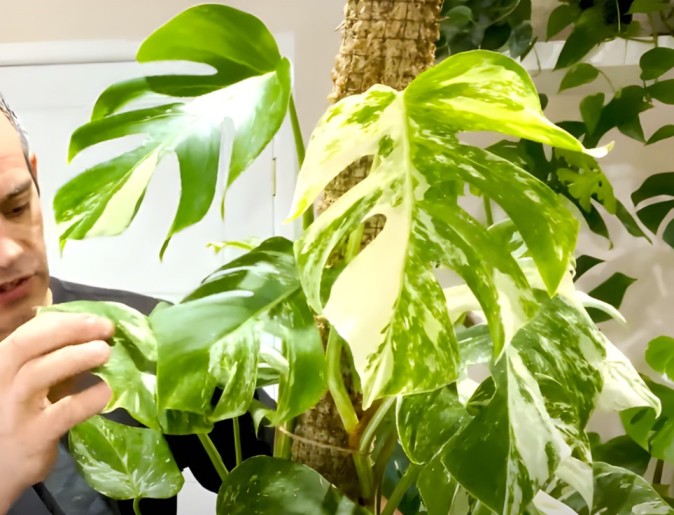
When Do Monstera Leaves Split?
Unlocking the magic of Monstera leaf splitting involves understanding the intricacies of this intriguing process.
A. Environmental conditions, plant age, and light exposure influence leaf-splitting timelines. During their young stages, plants may take their time splitting, but light and temperature provide the perfect environment for timely splitting.
Two to three years after the plant is planted, its leaves will split under the correct growing conditions.
so when do monstera leaves split is discussed in this article.
B. Impatient expectations are often the root of Monstera leaf splitting misconceptions. It is important to be patient when splitting leaves, as some believe they should split immediately.
Furthermore, excessive exposure to light can cause stress and impede the process. As a result, promoting healthy Monstera growth becomes more nuanced when these myths are dispelled.
How Do You Encourage Monstera Leaf Splitting?
Curating the perfect environment for your Monstera involves a delicate balance of elements.
Light Requirements
Let your Monstera enjoy the sun. You can encourage those coveted splits to form by placing it in bright, indirect light.
Ensure all sides of the plant receive equal sunlight, preventing uneven growth.
Fertilizer Tips
The fertilizer in Monstera’s smoothie is its power punch. During the growing season, use a water-soluble, well-balanced fertilizer.
You should feed your plants every 2-4 weeks to make sure they receive the nutrients they need to develop robust leaves.
Temperature Optimization
Monstera likes it cozy but not too hot. Maintain a temperature range between 65-75°F (18-24°C) for optimal leaf-splitting conditions.
Wind Considerations
There’s nothing wrong with swaying a little bit. Monstera responds naturally to gentle breezes by strengthening its stems, which promotes healthy leaf splitting.
Moderation is the key to leafy success; don’t let it blow you away.
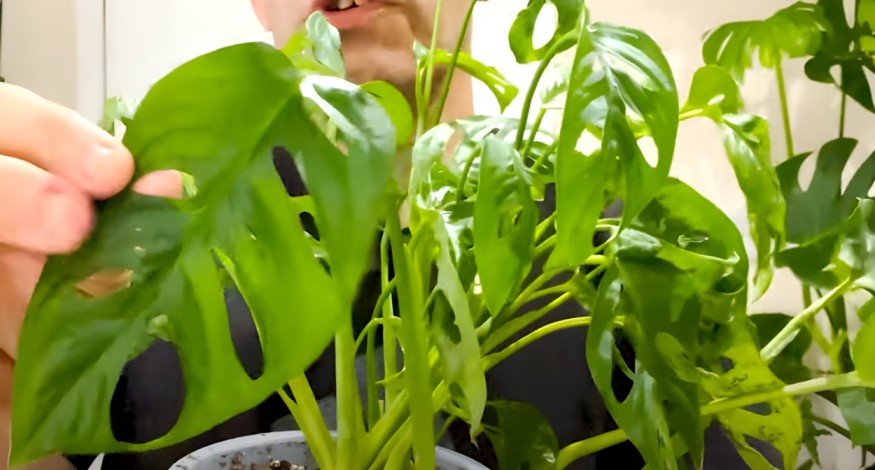
What does Monstera Split Mean?
Ever marveled at the captivating splits in your Monstera leaves? These elegant gaps, akin to nature’s artwork, hold both aesthetic wonder and botanical brilliance.
Interpretation of split leaves
Split leaves on Monstera aren’t just decorative; they’re nature’s survival strategy. They can be thought of as pieces of a green puzzle -each piece allows sunlight to pass through, maximizing photosynthesis.
Functional Aspects of Splits
Splits also serve a botanical purpose by facilitating drainage and air circulation. The leaves of monstera are similar in design to solar panels that efficiently harness sunlight.
What was the result? Increasing the health and vigor of the plant. When you admire Monstera, remember that its splits are not just a display of its beauty; they are also a testament to the ingenuity of its adaptation to its environment.
These natural masterpieces will enhance your indoor oasis with their beauty and functionality.
Reasons Your Monstera Leaves May Not Be Splitting
Plant Age Considerations
In the same way that humans go through their own growth journeys, Monstera plants do as well. Leaf splits may not appear in younger Monstera plants since they are still establishing themselves.
These exotic beauties mature slowly, and take time to become the stunning specimens we adore.
Light Deficiency
Sun is a favorite element of Monstera plants. You might find that your green friend hesitates to show off those elegant splits if it does not receive enough light.
In order to promote healthy leaf development, your Monstera needs bright, indirect sunlight.
Nutritional Deficiencies
- Monstera plants require nutrients, just like any other living thing.
- The development of leaves can be hindered if essential elements such as potassium and magnesium are lacking.
- You can unlock those captivating splits by feeding your plant a balanced fertilizer.
Stress Factors
The performance of Monstera plants might be affected by stress just as it is with humans. You can stress your plant by changing its environment, moving suddenly, or even over watering it.
You will be able to enjoy your Monstera’s glamorous leafy beauty by creating a serene atmosphere and avoiding abrupt changes.
Why Monstera Leaves Turn Color, Droop, or Curl
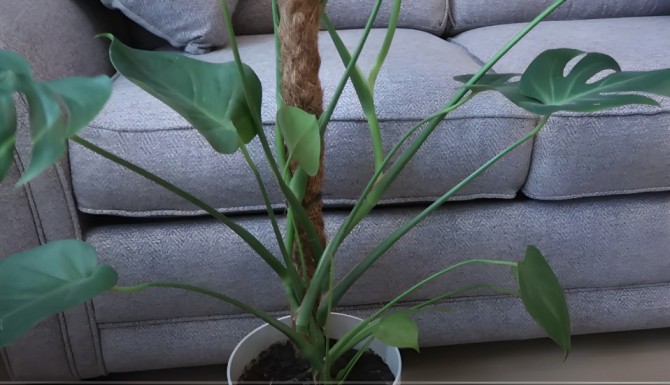
Understanding Leaf Variations
- Changing colors naturally:
- During the course of a tree’s life, leaves lose some of their vibrant green color and change to a deeper hue as they age.
- The Wonders of Variegation:
- Genetic variations are responsible for the unique patterning and colors of variegated varieties.
- Influence of the environment:
- The color of leaves is affected by different factors, including light intensity, temperature fluctuations, and humidity levels.
Also, make sure to check out our in-depth monstera aerial roots care guide.
Troubleshooting Common Issues
Underwatering vs. overwatering:
- The yellowing of an area indicates that it is being overwatered, whereas the drooping would indicate it is being underwatered. Find a balance.
Lighting is important:
- You should adjust the lighting according to your Monstera’s needs if it receives inadequate or excessive light.
Invaders of pests:
- Taking appropriate measures to combat pests can prevent curling
How to Keep Monstera Leaves Healthy
Follow this comprehensive guide for optimal leaf health:
- Light: Make sure your Monstera receives at least six hours of bright, indirect light each day.
- Make sure the soil dries between waterings by maintaining a consistent watering schedule.
- The humidity should be mimicked by misting the plant or using a humidifier when necessary.
- Use a balanced, diluted fertilizer when feeding your Monstera during the growing season.
- Root rot is preventable by using a well-draining, aerated soil.
- You can redirect energy towards healthy growth by pruning yellow or damaged leaves.
Recognizing Signs of Health
Identifying a thriving Monstera is essential. Look for:
- Health-promoting hues: Rich, green hues symbolize good health.
- It should feel turgid, not limp or crispy, when the leaves are healthy.
- Plants that produce leaves consistently are happy plants.
- Yellowing: Be aware of yellowing, which could indicate problems.
- The presence of new leaf nodes indicates that the plant is growing and thriving.
What to Do if Your Monstera Leaves Won’t Split
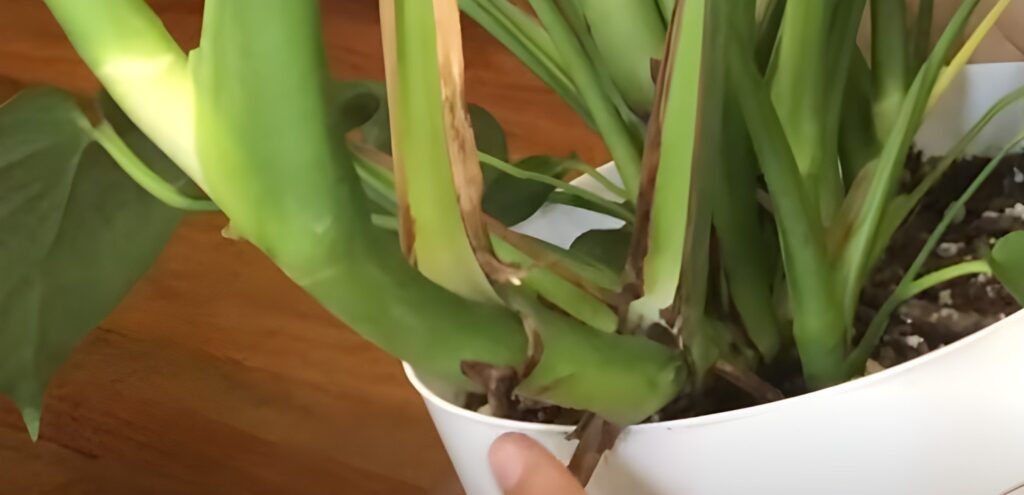
Troubleshooting Tips
- A Monstera should be mature enough to have splits; young plants may not have them.
- The exposure to light may be insufficient if the splitting is hindered. A bright, indirect light source is necessary for optimal growth.
- Make sure your Monstera receives the correct nutrients. Fertilizer levels can be adjusted if necessary.
Adjustments in Care Routine
- Gradually increase the duration and intensity of light exposure.
- A balanced fertilizer rich in essential nutrients is essential for optimizing fertilization.
- Keeping your plant warm and protected from harsh elements will ensure its success.
Do All Monstera Leaves Split?
Ever wondered if every Monstera leaf sports those iconic splits? Let’s dive into the fascinating world of Monstera leaves to understand the factors at play.
Genetic Influences
- Leaf split patterns are determined by Monstera’s DNA.
- More pronounced splits are caused by certain genetic variations.
- Depending on a plant’s genetic makeup, its leaves may exhibit unique characteristics.
Variegation Effects
- Split appearance can be affected by variegation or color variations.
- There is a possibility that variegated Monstera will have less defined splits or splits that are altered.
- Variegation and genetics combine to create leaf patterns with a wide variety of looks.
Encouraging Fenestrations in Monstera
Ever wondered how to transform your Monstera into a leafy masterpiece? Delight in the beauty of fenestrations with practical steps and propagation tips that make your Monstera stand out.
Practical Steps to Promote Splits
- You can promote healthy growth of your Monstera by placing it in bright indirect light.
- Keep your plants rotated for even exposure, encouraging symmetrical splits.
- To create the ideal environment for leaf growth, keep temperatures between 65-75°F (18-24°C).
- Plants are more likely to form splits when humidified. Mist the plant or use a humidifier to enhance humidity.
Propagation Tips
- To increase success rates when propagating stem cuttings, select stem cuttings that already have splits.
- Split leaf cuttings need a strong foundation for root growth. Rooting Hormone Magic stimulates root development.
- Before expecting new, split leaves to emerge from the propagated cutting, allow it to establish roots first.
Common Myths and Realities
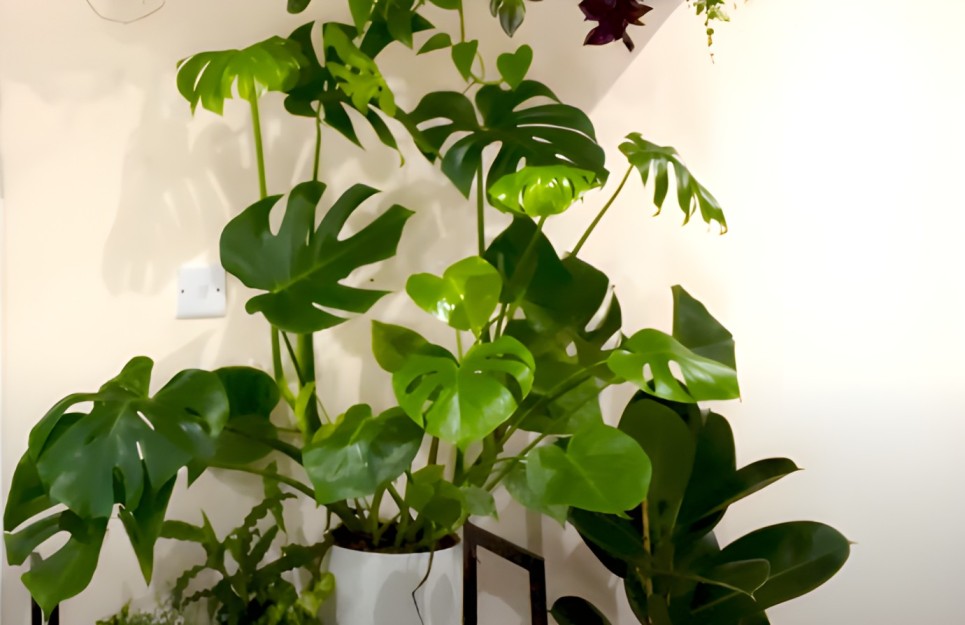
Debunking Misconceptions about Monstera Leaf Splitting
- Myth: Monstera leaves split only when the plant is mature.
- Reality: There are various stages of leaf growth at which leaf splits may occur, influenced by factors like light and genetics.
- Myth: Monstera leaves won’t split if the plant is indoors.
- Reality: The proper lighting and care of indoor plants can promote healthy leaf splitting.
- Myth: Pruning encourages Monstera leaf splitting.
- Reality: Growth can be stimulated by pruning, but splits are determined largely by environmental factors and genetics.
- Myth: All Monstera leaves should have the same number of splits.
- Reality: Genetics and environmental conditions determine how leaves split, creating unique patterns.
Clearing Up Common Doubts
- Doubt: Why won’t my Monstera leaves split?
- Solution: Ensure proper light exposure, nutrition, and age-appropriate care.
- Doubt: Can I speed up Monstera leaf splitting?
- Solution: Increase light conditions, Give proper nutrients, and be patient; it’s a natural process.
- Doubt: Do all Monstera varieties develop split leaves?
- Solution: While most Monstera varieties can develop splits, the degree varies based on species and genetics.
When Do Monstera Leaves Unveil Their Artistry? Exploring the Timeline and Patterns of Leaf Splitting
Monstera leaves, with their iconic splits and vibrant greenery, captivate plant enthusiasts, leading many to wonder, “When do Monstera leaves split?” The answer lies in the plant’s growth journey. Typically, Monstera leaves start to split as the plant matures, a process that can take 1 to 2 years.
The timing, however, varies based on factors such as light exposure, environmental conditions, and genetics. Interestingly, enthusiasts may eagerly anticipate the moment when do Monstera leaves split up or vertically, creating unique patterns.
Patience is key, as younger plants may take their time, and factors like water, light, and even the size of splits (0.5mm to 90 degrees) play a role.
As we navigate the intricacies of Monstera care, understanding the nuanced timeline of leaf splitting becomes essential for fostering healthy, thriving plants adorned with those sought-after splits.
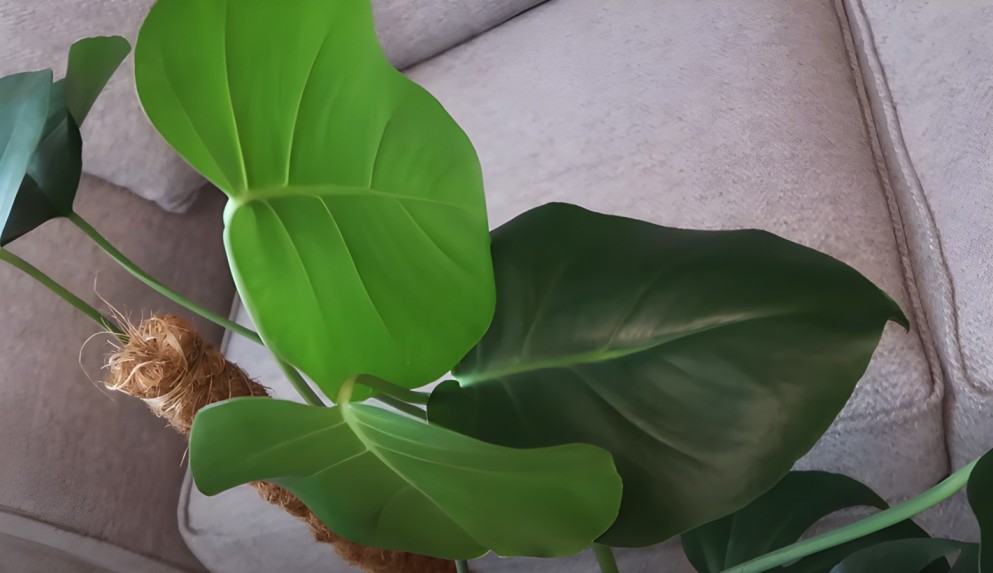
Conclusion
In this Article we discuss about why and when do monstera leaves split. As graceful decorations and intriguing botanical enigmas, Monstera plants flourish in the world of indoor gardening.
Observing Monstera leaf splits reveals an intriguing interplay between light, water, and temperature.
During the leaf-splitting phase of your Monstera, it is vital to understand the factors that influence its timeline.
This guide dispels myths about tropical plants and emphasizes patience as the key to nurturing them.
FAQs
Why do my Monstera leaves not have splits?
- Plants that are still establishing themselves may not have leaf splits due to their lack of maturity.
- For optimal growth, your Monstera should receive plenty of bright, indirect sunlight.
- Balanced fertilization can help address nutritional deficiencies like potassium and magnesium.
How do you know when to split a Monstera?
- In nature, Monstera leaves split naturally as they mature, depending on factors like age, light, and genetics.
- It seems that splits would be favorable at this time if leaf nodes were visible since they indicate ongoing growth.
- In order to promote timely leaf splitting, it is important to provide the plant with optimal care, including light, nutrition, and environmental factors.
Do Monstera leaves split after unfurling?
It varies by factors like age, light, and care. However, some Monstera leaves may exhibit splitting after unfurling.
What is it called when Monstera leaves split?
A Monstera leaf that has splits or holes is known as a fenestration. Sunlight filtration and air circulation are among the functions of these openings
How do you encourage splits in Monstera?
You can encourage healthy leaf growth and splits by placing your Monstera in bright, indirect light.
Providing essential nutrients for a robust leaf development requires a well-balanced, water-soluble fertilizer.
In order to optimize leaf splitting conditions, maintain a constant temperature range of 65-75°F (18-24°C).
How do you promote split leaves on Monstera?
Using indirect lighting will encourage symmetrical leaf splits on your Monstera.
Enhance the plant’s natural ability to form splits by misting or using a humidifier to boost humidity.
You need to use rooting hormone for successful propagation and choose healthy cuttings with existing splits
Can I split a Monstera in half?
Not recommended: While Monstera plants can tolerate pruning, splitting them in half is not advisable, as it may lead to stress and potential harm.
Why do Monstera leaves have holes?
Fenestrations in Monstera leaves evolved to maximize sunlight penetration, facilitate drainage, and stimulate air circulation.
Do genetics affect the likelihood of Monstera leaf splits?
In Monstera, leaf traits are influenced by its genetic makeup, affecting the pattern and likelihood of leaf splits.
Can Monstera stop producing split leaves?
The splitting of Monstera leaves can be temporarily halted or hindered by changes in care or environmental stress. Splits and renewed leaf development can be encouraged by adjusting care conditions.





